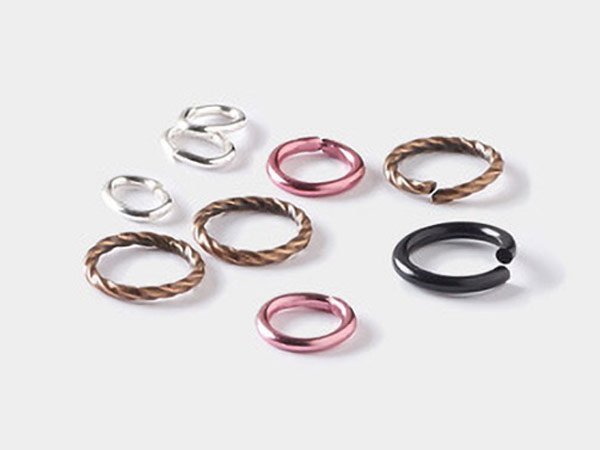How to Properly Use Jump Rings in Jewelry Design

Jump rings are essential components in jewelry making, serving various functions from connecting pieces to adding decorative elements. While they may seem simple, using jump rings correctly can greatly affect the durability and aesthetic of your jewelry. This guide will walk you through the proper techniques for using jump rings in your designs, ensuring your creations are both beautiful and long-lasting.
Understanding Jump Rings
Before diving into usage techniques, let’s explore what jump rings are. A jump ring is a small circular metal ring, typically made of materials like sterling silver, gold-filled, aluminum, or stainless steel. They come in various sizes and thicknesses, and are usually categorized into two types:
- Open Jump Rings: These are not completely closed and can be easily opened to connect components.
- Closed Jump Rings: These are permanently closed and cannot be opened. They are often used for chain links and other applications where a secure connection is crucial.
Choosing the Right Jump Ring
Before using jump rings, it’s essential to select the right type and size for your project. Here are some factors to consider:
- Material: Choose a material that matches the other components of your jewelry. For example, if you’re making a piece with sterling silver beads, use sterling silver jump rings to maintain a cohesive look.
- Size: The size of the jump ring should correspond with the elements you’re connecting. Larger jump rings are suitable for heavier pieces, while smaller ones work well for delicate designs.
- Gauge: The gauge (thickness) of the jump ring affects its strength. A thicker gauge is sturdier and can hold up larger components, while a thinner gauge is better for lightweight designs.
Proper Techniques for Using Jump Rings
1. Opening and Closing Jump Rings
One of the most crucial skills in using jump rings is knowing how to open and close them properly. Improper handling can lead to misshaped rings or weak connections. Follow these steps for best results:
Opening Jump Rings
- Tools Needed: Use two pairs of pliers—preferably flat-nosed or chain-nose pliers.
- Grip: Hold the jump ring with one pair of pliers in each hand.
- Twist: Instead of pulling the ends apart, gently twist the ring to the side. This motion maintains the circular shape and prevents the jump ring from becoming oval.
- Add Components: Once the ring is open, you can add your desired components, such as charms or other jewelry elements.
Closing Jump Rings
- Reposition: After adding components, position the ends of the jump ring back together.
- Twist Back: Using the same twisting motion, gently twist the ring back into shape until the ends meet.
- Check Alignment: Ensure that the ends are touching properly without gaps. This will help prevent components from slipping out.
2. Ensuring Durability
Properly opened and closed jump rings will ensure the longevity of your jewelry. Here are additional tips for enhancing durability:
- Use Soldered Jump Rings: For pieces that will experience a lot of movement or tension, consider using soldered jump rings, which are stronger than regular open jump rings.
- Double Up: In some designs, using two jump rings can create a more secure connection, especially for heavier components or chains.
- Test Connections: After closing a jump ring, gently tug on the components to ensure everything is secure before proceeding with the rest of your design.
3. Creative Applications of Jump Rings
Jump rings are versatile tools in jewelry design. Here are some creative ways to use them:
Connecting Components
Jump rings are most commonly used to connect various elements in jewelry. For example:
- Chain Links: Use jump rings to attach chain segments, creating necklaces, bracelets, or anklets.
- Charms and Pendants: Attach charms or pendants to necklaces or earrings using jump rings for an added decorative touch.
- Bead Strands: Connect bead strands by using jump rings as spacers or connectors, allowing for a more dynamic design.
Adding Movement
Jump rings can introduce movement in your designs, enhancing their visual appeal:
- Dangle Earrings: Create dangle earrings by using jump rings to attach beads or charms, allowing them to sway with movement.
- Layered Designs: Use jump rings to layer multiple chains or components, adding depth and interest to your pieces.
4. Troubleshooting Common Issues
Even seasoned jewelers can encounter challenges when working with jump rings. Here are some common issues and how to resolve them:
Misshapen Jump Rings
If a jump ring becomes misshapen during use:
- Fix It: Use a mandrel or round object to reshape it gently back into a circle.
- Use Quality Rings: Invest in high-quality jump rings that are less likely to deform.
Weak Connections
If you notice that your jump rings aren’t holding up:
- Check Gauge: Ensure you’re using the appropriate gauge for your design. Thicker jump rings may be necessary for heavier components.
- Reassess Techniques: Double-check your opening and closing techniques to ensure you’re properly securing the jump rings.
5. Tools and Materials
Using the right tools will make working with jump rings easier and more efficient. Here’s what you’ll need:
- Pliers: Invest in a good set of flat-nosed or chain-nose pliers for opening and closing jump rings. Needle-nose pliers can also be useful for precision work.
- Wire Cutters: If you’re working with thicker jump rings, wire cutters can help you adjust their size.
- Mandrel: A mandrel can be handy for reshaping any misshapen jump rings.
- Jewelry Findings: Keep a variety of jump rings on hand in different sizes and materials to match your design needs.
Conclusion
Jump rings are a fundamental component in jewelry design, offering both functional and decorative possibilities. By understanding how to properly open and close them, jump rings for jewelry choosing the right materials, and applying creative techniques, you can enhance the quality and aesthetics of your jewelry creations. Whether you’re a beginner or an experienced jewelry maker, mastering the use of jump rings will significantly improve your designs. So gather your tools, experiment with different applications, and let your creativity flow as you incorporate jump rings into your jewelry projects!
What's Your Reaction?















